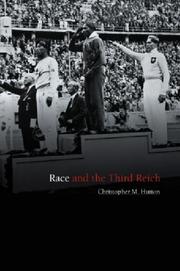| Listing 1 - 1 of 1 |
Sort by
|

ISBN: 9780745631776 Year: 2005 Publisher: Cambridge : Polity,
Abstract | Keywords | Export | Availability | Bookmark
 Loading...
Loading...Choose an application
- Reference Manager
- EndNote
- RefWorks (Direct export to RefWorks)
Christopher Hutton identifies the central figures involved in the study of race during the Nazi regime, and traces continuities and discontinuities between Nazism and the study of human diversity in the Western tradition. Whilst Nazi race theory is commonly associated with the idea of a superior "Aryan race" and with the idealization of the Nordic ideal of blond hair, blue eyes and a "long-skull", Nazi race theorists, in common with their colleagues outside Germany, without exception denied the existence of an Aryan race. After 1935 official publications were at pains to stress that the term "Aryan" belonged to linguistics and was not a racial category at all. Under the influence of Mendelian genetics, racial anthropologists concluded that there was no necessary link between ideal physical appearance and ideal racial character. In the course of the Third Reich, racial anthropology was marginalized in favour of the rising science of human genetics. However, racial anthropologists played a key role in the crimes of the Nazi state by defining Jews and others as racial outsiders to be excluded at all costs from the body of the German Volk.
Drittes Reich. --- Linguistik. --- Nationaal-socialisme. --- National socialism. --- National socialism. --- Nazism. --- Nazisme. --- Race relations --- Race relations --- Race relations. --- Rasrelationer --- Rasrelationer --- Rassenpolitik. --- Rassentheorieën. --- Relations raciales --- Political aspects. --- Political aspects. --- Politiska aspekter. --- Aspect politique. --- Günther, Hans F. K., --- BMBF-Statusseminar. --- Allemagne --- Deutsch. --- Deutschland. --- Germany --- Germany. --- Relations raciales. --- Race relations.
| Listing 1 - 1 of 1 |
Sort by
|

 Search
Search Feedback
Feedback About UniCat
About UniCat  Help
Help News
News